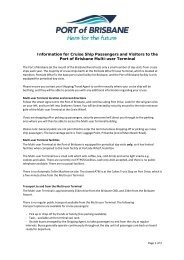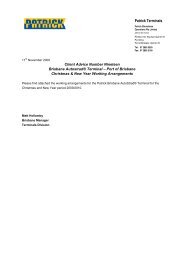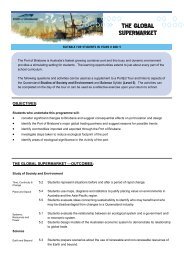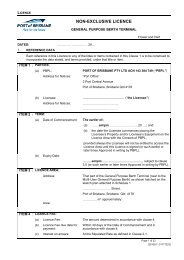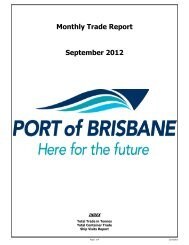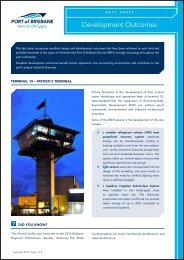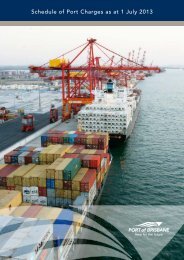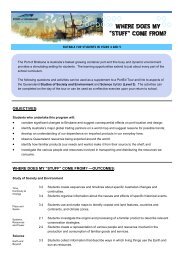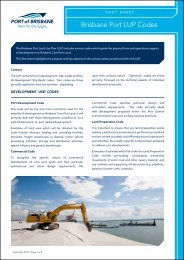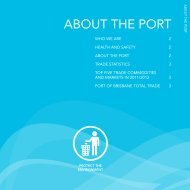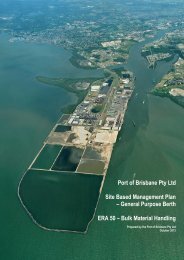AROUND THE WORLD IN A MORNING
A709971 (Read-Only) - Port of Brisbane
A709971 (Read-Only) - Port of Brisbane
- No tags were found...
Create successful ePaper yourself
Turn your PDF publications into a flip-book with our unique Google optimized e-Paper software.
<strong>AROUND</strong> <strong>THE</strong><br />
<strong>WORLD</strong> <strong>IN</strong> A MORN<strong>IN</strong>G<br />
SUITABLE FOR STUDENTS <strong>IN</strong> YEARS 6 AND 7<br />
The Port of Brisbane is Australia’s fastest growing container port and this busy and dynamic environment<br />
provides a stimulating setting for students. The learning opportunities extend to just about every part of the<br />
school curriculum.<br />
The following questions and activities can be used as a supplement to a PortEd Tour and link to aspects of the<br />
Queensland Studies of Society and Environment and Science Syllabi (Level 4). The activities can be<br />
completed on the day of the tour or can be used as a reflective exercise upon your return to school.<br />
OBJECTIVES:<br />
Students who undertake this program will:<br />
• analyse evidence of change to Brisbane’s port;<br />
• develop an understanding of our dependence on imported products in our everyday lives;<br />
• identify how familiar products (our needs and wants) make it from their source to the shelf;<br />
• categorise import and export resources and consider the production and consumption of these resources;<br />
• investigate the various people and resources involved in transporting and distributing the resources we<br />
consume;<br />
• identify on maps global patterns of trade;<br />
• identify Australia’s major global trading partners and suggest reasons for these trends; and<br />
• predict how specific Australian industries link to global economic and ecological systems.<br />
<strong>AROUND</strong> <strong>THE</strong> <strong>WORLD</strong> <strong>IN</strong> A MORN<strong>IN</strong>G—OUTCOMES:<br />
Study of Society and Environment<br />
Time,<br />
Continuity &<br />
Change<br />
4.1 Students use primary sources to investigate situations before and after change in<br />
Australian or global settings.<br />
Place and<br />
Space<br />
4.1 Students make justifiable links between ecological and economic factors and the<br />
production and consumption of a familiar resource.<br />
4.4 Students use latitude, longitude, compass and scale references and thematic maps to<br />
make inferences about global patterns.<br />
Systems, Resources<br />
and Power<br />
Science<br />
Earth and<br />
Beyond<br />
4.1 Students outline how Australian industries link to global economic and ecological systems.<br />
4.3 Students summarise information to compare ways in which different communities use<br />
resources from the Earth and beyond.<br />
Natural &<br />
Processed<br />
Materials<br />
4.3 Students examine and assess ways that materials can be changed to make them more<br />
useful.
<strong>AROUND</strong> <strong>THE</strong><br />
<strong>WORLD</strong> <strong>IN</strong> A MORN<strong>IN</strong>G<br />
Have you ever wondered exactly where your stuff comes from? I mean,<br />
before it arrives in the shop for you to buy? PB is here to tell you the<br />
story behind some familiar products.<br />
People’s needs and wants have changed over-time. As a result, Brisbane’s<br />
seaport has gone through many changes too.<br />
IMAGE ONE: In the mid to late 1800s, port activities occurred in the City Reach of the Brisbane River between Kangaroo Point and Victoria<br />
Bridge—now South Bank.<br />
ACTIVITY ONE: Brisbane’s seaport has changed significantly since this<br />
photo was taken in the 1800’s. List as many differences between this<br />
historical image and what you saw on your tour.<br />
• Brisbane’s port has moved to the _____________ of the Brisbane River.<br />
• The railway lines no longer run right beside the ____________ .<br />
• The ships are ________________ now.<br />
• ______________ are now used to load and unload ships instead of people.
<strong>AROUND</strong> <strong>THE</strong><br />
<strong>WORLD</strong> <strong>IN</strong> A MORN<strong>IN</strong>G<br />
Each of the things we buy has a story attached to it, which tells of the journey it has travelled<br />
before arriving on the store shelf.<br />
ACTIVITY: Listen to the story ‘Around the World in a Morning’. Colour the dots<br />
on the map as you hear a country or city mentioned. At the end of the story you<br />
will see how aspects of your daily life connect you to the global<br />
community.<br />
ARCTIC OCEAN<br />
NORTH<br />
ATLANTIC<br />
OCEAN<br />
Germany<br />
Saudi Arabia<br />
India<br />
South Korea<br />
Taiwan<br />
Japan<br />
PACIFIC OCEAN<br />
United States<br />
of America<br />
Thailand<br />
Philippines<br />
Indonesia<br />
SOUTH<br />
ATLANTIC<br />
OCEAN<br />
<strong>IN</strong>DIAN OCEAN<br />
Australia<br />
SOU<strong>THE</strong>RN OCEAN<br />
1. Describe the region that appears to trade the most with Australia in this story.<br />
_________________________________________________________________<br />
_________________________________________________________________<br />
2. Tick the statements that help to explain why we trade most with this region:<br />
• This region is located close to Australia.<br />
• Australia imports a large amount of manufactured goods from this region.<br />
• All the goods and resources Australian’s need come from this region.
<strong>AROUND</strong> <strong>THE</strong><br />
<strong>WORLD</strong> <strong>IN</strong> A MORN<strong>IN</strong>G<br />
Many of the goods you purchase are not made in Australia, therefore they have to be imported<br />
from another country.<br />
ACTIVITY: Tick the items that you have at home.<br />
In order for us to have the goods that we want and need, it takes many people and a range of<br />
resources to transport these products to our local store.<br />
ACTIVITY: The jumbled sequence below explains the journey of petrol from its raw<br />
form to the petrol pump. Correct the sequence by numbering the steps 1—4.<br />
The petrol is transported by truck<br />
to a petrol station<br />
for you to pump<br />
into your car.<br />
Crude oil is drilled from<br />
underground sources<br />
in countries such as<br />
Papua New Guinea,<br />
Indonesia & Saudi Arabia.<br />
Oil is shipped from Papua New<br />
Guinea &<br />
Indonesia to<br />
Australia.<br />
A petrol company refines the oil<br />
into petrol.
<strong>AROUND</strong> <strong>THE</strong><br />
<strong>WORLD</strong> <strong>IN</strong> A MORN<strong>IN</strong>G<br />
During your tour of the Port of Brisbane, you saw a number of resources that are used by<br />
humans—both natural and manufactured.<br />
ACTIVITY: Match statements A—D with the correct resources pictured below.<br />
A. This natural resource is exported to Japan where they use it to make newspaper.<br />
B. This natural resource is exported to Japan and Korea where they use it to<br />
generate electricity.<br />
C. This natural resource is imported to Australia from Papua New Guinea, Indonesia<br />
and Saudi Arabia to make petrol for vehicles.<br />
D. This manufactured good contains natural resources mined in Adelaide and<br />
Gladstone. We use this resource to bind bricks together in buildings.<br />
CRUDE OIL<br />
COAL<br />
CEMENT<br />
WOODCHIP<br />
A port is a place where ships come to load and unload goods.<br />
Imports are goods that are coming into Australia.<br />
Exports are goods that are going out of Australia.<br />
Resources: Something we use to satisfy our needs.<br />
Natural Resources: The parts of natural systems such as soil, trees,<br />
water and minerals that we use to satisfy our needs.<br />
Manufactured Goods: Goods that are made (not found in nature).




